
Pilipinas Shell Petroleum Corp. is setting aside as much as P20 billion to finance its 5-year strategic priorities, which include the construction of more import terminals, additional service stations and renewable energy (RE) investments.
“In the next 5 years, Pilipinas Shell will have three major changes in its strategic priorities. First is transforming its supply chain from manufacturing to full importation; second is changing its business model from retail to mobility; and third is shifting to lower carbon operations and introducing lower carbon products and services,” the company said in a statement.
The amount would be financed using internal funds, said company chief finance officer Rey Abilo. Should there be a need to borrow, Pilipinas Shell has credit lines worth over P60 billion.
“We have over P60 billion of untapped credit lines. That’s our borrowing capacity for short and long term,” he said during an online press briefing.
Pilipinas Shell President and CEO Cesar Romero said yearly spending during the 5-year period starting this year would be P3 billion to P4 billion annually. Of which, 60 percent is allocated to retail business and 40 percent to trading and supply.
“In terms of investment, we are hoping that we would be able to continue with our investment profile anywhere from P3 to 4 billion per year for the next 5 years,” he said during the briefing, adding that the amount is “consistent” with previous years’ spending.
The difference now is that the amount would be utilized to invest more in retail and to improve the efficiency of the oil firm’s supply chain.
“Before, when had refinery the business, our spending was P1 billion per year just for asset integrity and basic maintenance. Whereas now, we will be spared of that value and could redeploy the capex to really value adding investments, either in terms of margin or revenue generation or in terms of cost reduction,” Romero said.
The oil firm’s retail business model will shift from a gas station to a mobility site, which will not only cater to cars and standard vehicles, but will also have offers in e-mobility for cyclists and pedestrian customers.
Pilipinas Shell aims to build 60 to 80 new sites per year to reach its overall target of having 1,500 mobility sites by 2025, achieving its goal to grow alongside the Philippine economy by increasing fuels volumes by about 4 percent per year and convenience retail profits by about 15 percent per year.
Shifts
Part of its 5-year growth strategy is the shift from a manufacturing supply chain to a full import supply chain, starting with the transformation of its Tabangao refinery. The 110,000 barrels per day refinery in Batangas ceased to operate in August last year.
“We will continue our investment in Tabangao. We have identified around one to two billion pesos for next three years to make it into a world-class facility,” Romero said.
From a refinery, the Tabangao facility is being transformed into a world-class Medium Range (MR) capable import terminal capable of handling at least 300,000 barrels per day.
Further, it will construct more MR capable import terminals to bring the number to five by 2025. Pilipinas Shell currently has 3 operating import terminals in Batangas, Cagayan de Oro, and Subic. The additional two will be put up either in Visayas or Mindanao.
“We believe that growth of the country will be in the south so it will be either Visayas or Mindanao. It does not mean we will preclude investments in the north. We follow where we believe economic activity will grow. We believe five is a good number to allow us to have a network of import facilities,” said Romero.
Abilo said financing for the additional import terminals would likewise be sourced internally.
Pilipinas Shell is also gearing up to innovate low carbon and carbon offset products while shifting to low carbon operations. The initiatives include putting up electric vehicle charging stations; installation of solar panels in various service stations and import terminals; and implementing more sustainable hybrid-mini grids.
With the roll out of its 5-year strategic plans in full swing, the oil company is expecting to “go back to profitable levels” this year. Pilipinas Shell ended 2020 with a net loss of P16.18 billion due to one-time charges. A big chunk of the company’s net loss recorded last year stemmed from its decision to convert the refinery. This cost the company about P12 billion. Also, about P4.8 billion was recorded as inventory loses due to the drastic decline in crude prices.
“We don’t expect to have that again in 2021. With our strategy in place, hopefully we can go back to profitable levels. Our volume aspiration is to grow in line with the GDP,” said Romero.
Read full article on BusinessMirror

